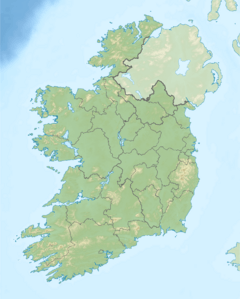River Cong (Ireland) facts for kids
Quick facts for kids River Cong |
|
|---|---|

River Cong
|
|
|
Source of the River Cong within County Mayo
|
|
| Native name | Abhainn Chonga |
| Country | Ireland |
| County | County Galway County Mayo |
| Province | Connacht |
| Physical characteristics | |
| Main source | Village of Cong, County Mayo |
| River mouth | Flows into Lough Corrib 53°31′58″N 9°17′04″W / 53.53276°N 9.28451°W |
| Length | 1 mi (1.6 km) |
The River Cong (called Abhainn Chonga in Irish) is a short but important river in Ireland. It flows mostly through County Mayo but also touches County Galway. It's known for its clear waters and strong flow.
Contents
River's Journey
The River Cong starts near the village of Cong in County Mayo. It's quite unique because its water comes from underground. Water from Lough Mask, a lake about four miles (6.4 km) north, flows through cracks in the limestone rock. This water then comes out of the ground near Cong village.
The river is only about one mile (1.6 km) long. However, it can be as wide as 100 yards (91 m) in some spots! At one point, an island splits the river into two parts. The River Cong flows strongly past the famous Ashford Castle before emptying into Lough Corrib.
Fun on the River
The River Cong is a very popular spot for people who love to fish. It has a special hatchery for salmon, which helps to keep the river stocked. Many salmon swim up the river, especially in spring.
Fishing for Salmon
The best time to catch spring salmon is usually in April. After that, in May, a type of salmon called grilse arrives. June and early July are also excellent times for fishing. You can still catch salmon later in the season, but in smaller numbers.
Trout Fishing
The river is also home to large brown trout, known as ferox trout. These fish are a big catch for anglers.
Access for Anglers
Some parts of the river are open for anyone to fish. Other parts are managed by Ashford Castle. Local fishing guides, called gillies, are available to help visitors.
The Cong Canal Project
Back in 1848, people tried to build a canal to connect Lough Mask and Lough Corrib. The idea was to make it easier to travel between the two lakes. The canal was planned to run from Lough Mask south to Cong, and then east of the river.
Why the Canal Failed
Workers continued building the canal during the summer months for five years. However, the project was not managed well. Even though they dug out all three miles and built two of the three planned locks, the work stopped in 1854.
One big problem was finding swallow holes in the limestone rock. These are natural holes where water can disappear underground. Some people, like Sir William Wilde, later blamed these holes for the project's failure. However, the canal was never actually filled with water. It's more likely that new railways, which offered faster transport, made the canal seem less important.


